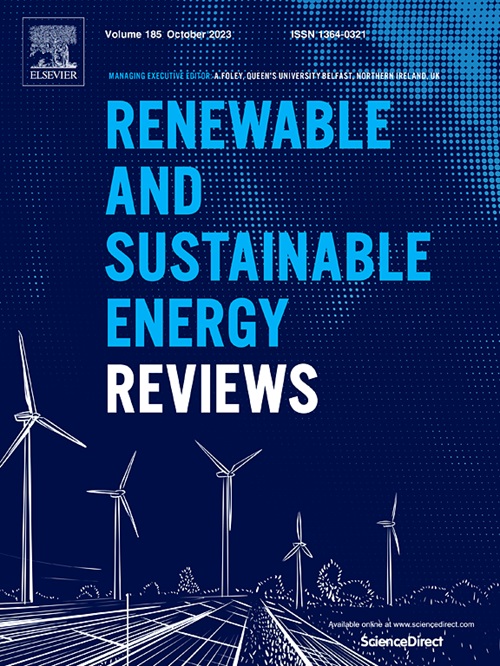海洋热梯度相变材料及热电发生器研究进展
IF 16.3
1区 工程技术
Q1 ENERGY & FUELS
引用次数: 0
摘要
由于无人水下航行器(uuv)电池储能容量有限,海洋热能有可能解决平衡长期运行和高频监测的挑战。已经提出了几种为UUV、剖面浮标和其他海洋应用提供动力的新兴技术,包括热电发电机(teg)、相变材料(PCMs)和记忆形状合金。然而,这些技术中的大多数仍处于开发的早期阶段,尚未在商业规模上部署。在本研究中,我们对利用海洋热梯度的teg和pcm进行了全面的综述。本文将重点介绍teg和pcm的特性、性能和进展,以解决技术限制,推进海洋动力应用的部署,如海洋热能驱动的商业规模的uuv。首先,本文对不同的pcm、teg进行了全面的综述,重点介绍了它们的热物理性能。然后,根据pcm和teg的技术属性和美国海洋热梯度势,提出了pcm和teg在不同地点和季节的选择。海洋热梯度提供了稳定的年储存潜力,约为1.09 × 1019 MJ,其中约7.63 × 1017 MJ可利用,效率为7%。尽管基于pcm的uuv是海洋热梯度应用中最有前途的替代方案之一,但低传热率、低能量转换效率(在0.14%至0.6%之间)和低能量存储密度(约0.26 Wh/kg)是有效商业规模应用的主要挑战。本研究确定了适合海洋热应用的关键pcm,包括有机、无机和共晶pcm,熔融焓范围为100至250 kJ/kg。它还评估了不同海洋位置和季节变化的各种teg。通过增强材料和创新设计,将pcm与teg集成在一起的最新进展显著提高了能量转换性能,使用金属泡沫将导热系数提高了15倍,使用纳米材料将导热系数提高了10倍。pcm和teg的集成为未来的uuv、剖面浮标和其他海洋动力技术(包括水产养殖和海水淡化)提供了可行的替代方案。本文章由计算机程序翻译,如有差异,请以英文原文为准。
Review on phase change materials and thermoelectric generators for ocean thermal gradient applications
Ocean thermal energy has the potential to address the challenge of balancing long-term operation and high-frequency monitoring due to the limited energy storage capacity of batteries for unmanned underwater vehicles (UUVs). Several emerging technologies to power UUV, profiling floats, and other ocean applications, including the thermoelectric generators (TEGs), phase change materials (PCMs), and memory shape alloys have been proposed. However, most of these technologies are still in an early stage of development and have not been deployed on a commercial scale. In this study, we conducted a comprehensive review on TEGs and PCMs to harness ocean thermal gradients. This review is focused on TEGs' and PCMs' characteristics, properties, and progress to address technical limitations to advance towards the deployment in ocean power applications, such as ocean thermal energy-powered UUVs at a commercial scale. First, the paper provides a thorough review of the different PCMs, TEGs, focusing on enhancing their thermophysical properties. Then, based on their technical attributes and the ocean thermal gradient potential in the United States, a selection of PCMs and TEGs is proposed for different locations and seasons. The ocean thermal gradient offers a stable annual storage potential of approximately 1.09 × 1019 MJ, with about 7.63 × 1017 MJ being harnessable with an efficiency of 7 %. Despite PCM-based UUVs is one the most promising alternatives for ocean thermal gradient applications, the low heat transfer rates, low energy conversion efficiency (between 0.14 % and 0.6 %), and low energy storage density (around 0.26 Wh/kg) are the main challenges for effective commercial scale applications. This study identifies key PCMs suitable for ocean thermal applications, including organic, inorganic, and eutectic PCMs, with melting enthalpies ranging from 100 to 250 kJ/kg. It also evaluates various TEGs for different oceanic locations and seasonal variations. Recent advancements in integrating PCMs with TEGs, through enhanced materials and innovative designs, have significantly improved energy conversion performance, increasing thermal conductivity by up to 15 times using metal foams and 10 times using nanomaterials. The integration of PCMs and TEGs offers a feasible alternative to power future UUVs, profiling floats, and other ocean power technologies, including aquaculture farming and water desalination.
求助全文
通过发布文献求助,成功后即可免费获取论文全文。
去求助
来源期刊

Renewable and Sustainable Energy Reviews
工程技术-能源与燃料
CiteScore
31.20
自引率
5.70%
发文量
1055
审稿时长
62 days
期刊介绍:
The mission of Renewable and Sustainable Energy Reviews is to disseminate the most compelling and pertinent critical insights in renewable and sustainable energy, fostering collaboration among the research community, private sector, and policy and decision makers. The journal aims to exchange challenges, solutions, innovative concepts, and technologies, contributing to sustainable development, the transition to a low-carbon future, and the attainment of emissions targets outlined by the United Nations Framework Convention on Climate Change.
Renewable and Sustainable Energy Reviews publishes a diverse range of content, including review papers, original research, case studies, and analyses of new technologies, all featuring a substantial review component such as critique, comparison, or analysis. Introducing a distinctive paper type, Expert Insights, the journal presents commissioned mini-reviews authored by field leaders, addressing topics of significant interest. Case studies undergo consideration only if they showcase the work's applicability to other regions or contribute valuable insights to the broader field of renewable and sustainable energy. Notably, a bibliographic or literature review lacking critical analysis is deemed unsuitable for publication.
 求助内容:
求助内容: 应助结果提醒方式:
应助结果提醒方式:


